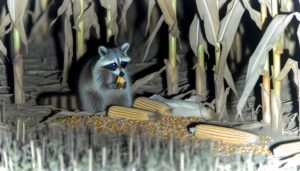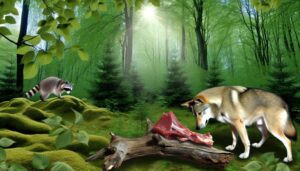Do Raccoons Eat Raw Meat?
Raccoons do eat raw meat, which constitutes a significant portion of their diet due to their omnivorous and opportunistic feeding behavior. They commonly hunt small mammals, birds, insects, and amphibians, adjusting their diet based on seasonal prey availability.
During winter, their predation on small mammals and birds intensifies, while in summer, their diet includes more fruits and insects. Raccoons are adept at scavenging and often raid human refuse for additional food sources.
This adaptable diet and hunting skill impact local ecosystems by altering predator-prey dynamics. More insights reveal their complex interaction with the environment and humans.

Key Takeaways
- Raccoons are omnivores with a significant portion of their diet consisting of raw meat.
- They hunt and consume small mammals, birds, insects, and amphibians.
- Raccoons adapt their diet seasonally, often increasing raw meat intake in winter.
- Scavenging for carrion is a common behavior, adding raw meat to their diet.
- Their meat consumption affects local ecosystems and predator-prey dynamics.
Raccoons' Natural Diet
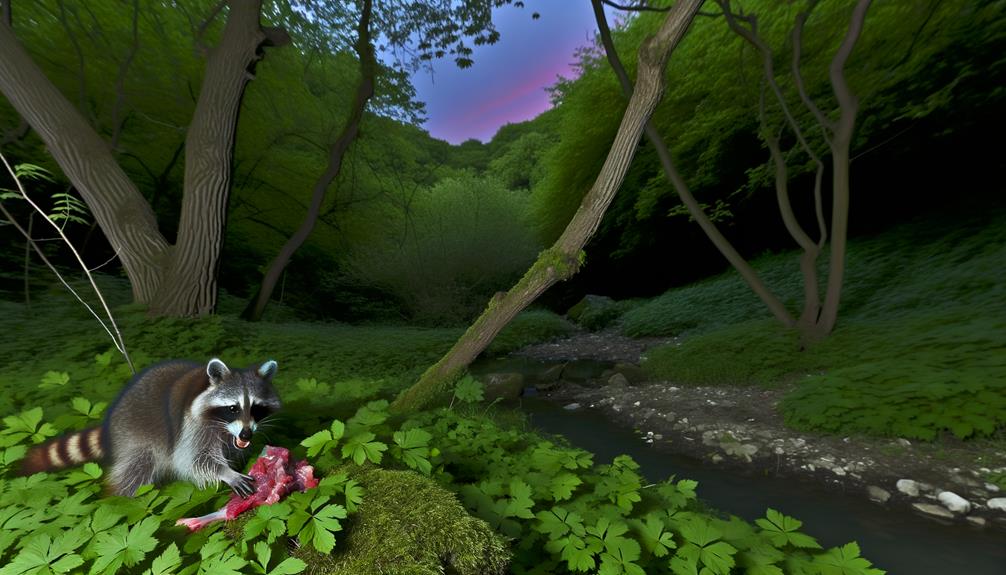
Raccoons (Procyon lotor) exhibit an omnivorous diet, consuming a diverse array of food sources that include fruits, nuts, insects, and small vertebrates. Studies indicate that raccoons adjust their feeding habits based on seasonal availability, demonstrating a high degree of dietary flexibility.
In autumn, they mainly consume mast such as acorns and other nuts, while in spring and summer, their diet shifts towards fruits, berries, and invertebrates. Analysis of raccoon scat has revealed the presence of various plant materials and animal matter, highlighting their opportunistic foraging behavior.
Moreover, raccoons are known to exploit anthropogenic food sources, including garbage and pet food, which underscores their adaptability to urban environments. This broad dietary spectrum secures their survival across diverse habitats.
Carnivorous Tendencies
Raccoons exhibit distinct carnivorous tendencies, driven by their natural hunting instincts which enable them to capture small animals such as insects, amphibians, and rodents. Common meat sources for raccoons include fish and bird eggs, reflecting their opportunistic feeding behavior.
Additionally, seasonal dietary changes influence their meat consumption, with higher predation rates observed during warmer months when prey availability is increased.
Natural Hunting Instincts
Possessing keen natural hunting instincts, raccoons demonstrate a strong proclivity for carnivorous tendencies, often hunting and consuming various forms of raw meat.
Behavioral studies indicate that raccoons have developed adept skills in locating and capturing prey, utilizing their acute sense of smell and tactile sensitivity.
Empirical data suggest that their diet diversification is partly an adaptive response to environmental pressures, enhancing their survival odds. These innate predatory behaviors are observed more frequently in habitats where food scarcity necessitates active hunting.
Moreover, raccoons' anatomical features, such as sharp claws and robust dentition, facilitate the efficient killing and consumption of small animals. This carnivorous inclination underscores the raccoon's role within its ecological niche as an opportunistic predator.
Common Meat Sources
Among the most common meat sources for raccoons are small mammals, birds, insects, and amphibians, reflecting their opportunistic feeding behavior and adaptability to diverse environments.
Studies indicate that raccoons (Procyon lotor) exhibit a diet composition where these meat sources constitute approximately 40-60% of their intake in certain habitats.
Small mammals such as rodents are frequently targeted, while avian prey includes eggs and fledglings.
Insects, particularly beetles and larvae, provide essential proteins and fats, contributing to their nutritional requirements.
Amphibians, including frogs and salamanders, are also commonly consumed, particularly in wetland areas.
This diverse carnivorous diet underscores the raccoon's ability to exploit various ecological niches, enhancing their survival and reproductive success across a range of environments.
Seasonal Dietary Changes
Seasonal variations greatly influence the carnivorous tendencies of raccoons. Shifts in prey availability and metabolic demands drive changes in their dietary patterns. During spring and summer, when small mammals, amphibians, and invertebrates are abundant, raccoons exhibit increased carnivorous behavior. Studies indicate that up to 40% of their diet can consist of these protein-rich sources during warmer months.
Conversely, in fall and winter, as prey becomes scarce and raccoons prepare for lower metabolic activity, their diet shifts to include more plant-based foods such as nuts and fruits. This seasonal adaptability underscores the omnivorous nature of raccoons and their ability to optimize nutrient intake according to environmental conditions, ensuring survival across diverse habitats and climatic conditions.
Protein Sources
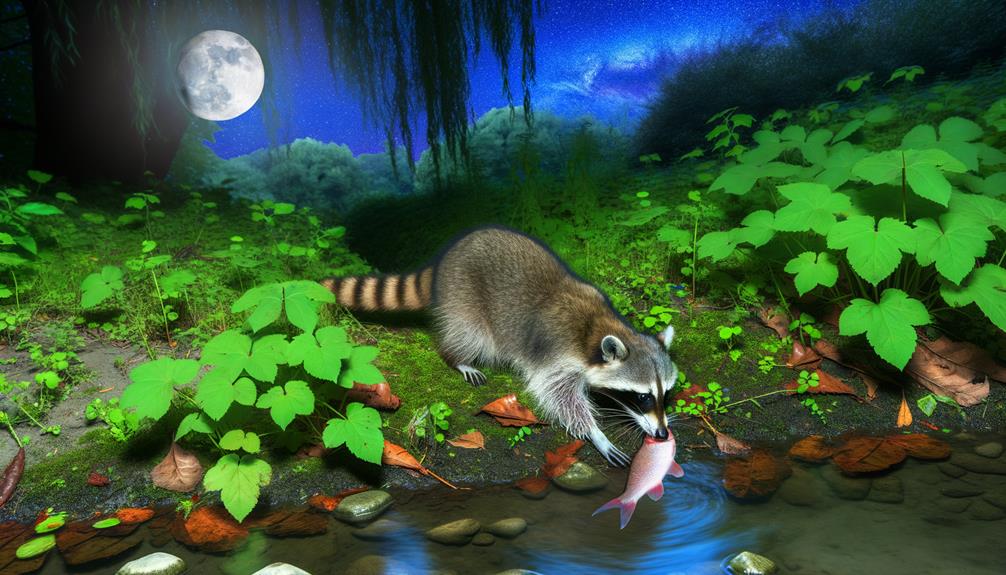
Raccoons, being omnivorous mammals, rely on various protein sources, including raw meat, to meet their dietary needs. Their protein intake is critical for growth, reproduction, and overall health. Research indicates that raccoons exhibit a diverse diet, incorporating both animal and plant-based proteins.
Key protein sources for raccoons include:
- Insects: A significant portion of their diet, providing essential amino acids.
- Small Mammals: Such as rodents, which are abundant and rich in proteins.
- Birds and Eggs: Offering high nutritional value with accessible protein content.
- Fish: Frequently consumed in aquatic environments, contributing to their protein intake.
- Carrion: Decomposing animal matter that serves as an opportunistic protein source.
Understanding these protein sources highlights the adaptability and dietary flexibility of raccoons in their natural habitats.
Foraging Behavior
In their quest for sustenance, raccoons exhibit highly adaptable and opportunistic foraging behavior that maximizes their access to diverse food sources. This behavioral flexibility is evidenced by their ability to thrive in various environments, from urban areas to natural habitats.
Studies have shown that raccoons utilize a combination of memory, sensory cues, and environmental familiarity to locate food effectively. Their diet includes fruits, insects, small vertebrates, and human refuse, indicating a high degree of dietary plasticity.
Additionally, raccoons are known to forage both during day and night, depending on food availability and predation risks. This adaptive foraging strategy contributes significantly to their survival and reproductive success, underscoring their role as generalist feeders within their ecosystems.
Hunting Skills
Raccoons exhibit significant natural predatory instincts, utilizing their sharp claws and dexterous front paws to capture and handle prey.
Their nocturnal foraging behavior enhances their hunting efficiency, allowing them to exploit the cover of darkness to ambush small animals.
Data indicates that raccoons primarily target insects, amphibians, and small mammals, highlighting their adaptability as opportunistic predators.
Natural Predatory Instincts
Despite their reputation as opportunistic omnivores, raccoons possess well-developed hunting skills that enable them to capture and consume a variety of prey. Their sharp claws and dexterous front paws are critical for manipulating and securing their prey.
Raccoons exhibit a range of behaviors that underscore their predatory instincts, including:
- Tactile Sensitivity: Their highly sensitive front paws allow them to detect and capture small animals in dark or murky environments.
- Climbing Proficiency: Raccoons can climb trees and structures to access nests or roosting birds.
- Aquatic Hunting: They are adept at catching fish, crayfish, and amphibians in shallow waters.
- Ambush Tactics: Utilizing stealth and patience, raccoons can effectively ambush unsuspecting prey.
- Adaptability: Their ability to thrive in diverse habitats enhances their hunting efficiency.
Nocturnal Foraging Behavior
Nocturnal foraging behavior in raccoons is characterized by their ability to exploit a wide range of food sources under the cover of darkness. Studies have shown that raccoons possess highly adaptable hunting skills, enabling them to seek out both plant-based and animal-based foods.
Their keen sense of smell and dexterous front paws allow them to locate and manipulate potential prey, including insects, small mammals, and raw meat. Raccoons exhibit opportunistic feeding patterns, often scavenging on carrion or raiding bird nests for eggs.
Data from nocturnal tracking studies indicate that raccoons can cover several kilometers in a single night, optimizing their foraging efficiency. This ability to forage effectively at night underscores their survival adaptability in diverse environments.
Scavenging Habits
A significant aspect of raccoons' scavenging habits involves their opportunistic feeding behavior, which allows them to exploit a wide range of food sources. This adaptability is vital for their survival in diverse environments, from urban areas to dense forests.
Their scavenging behavior is characterized by several key attributes:
- Varied Diet: Raccoons consume fruits, nuts, insects, small mammals, and carrion.
- Nocturnal Activity: They primarily forage at night, reducing competition and predation risks.
- Dexterous Paws: Their highly developed front paws enable them to manipulate objects and access food.
- Intelligence: Raccoons possess problem-solving skills that aid in locating and acquiring food.
- Habitat Flexibility: They thrive in both natural and human-modified environments due to their adaptable scavenging strategies.
These factors collectively enhance raccoons' ability to efficiently scavenge for sustenance.
Raw Meat Preferences
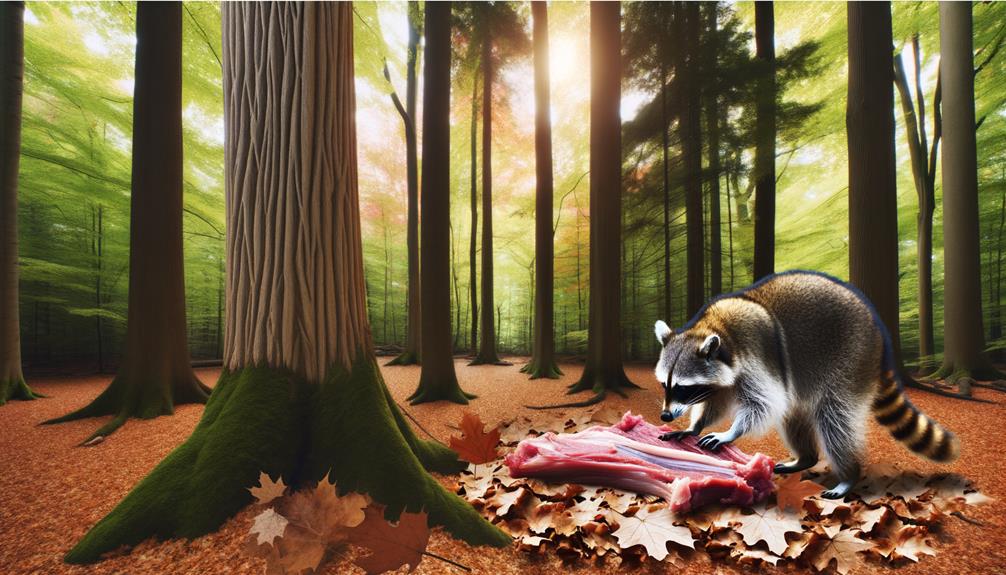
Raccoons exhibit a marked preference for raw meat, which constitutes a significant portion of their protein intake in various habitats. Studies indicate that raccoons frequently consume raw meat from diverse sources such as small mammals, birds, amphibians, and insects.
Analysis of raccoon scat samples reveals that up to 60% of their diet may be composed of raw meat, depending on availability. This inclination is driven by the high protein and fat content found in raw animal matter, which is vital for their energy requirements and reproductive success.
Moreover, raccoons employ opportunistic feeding strategies, often capturing live prey or scavenging from carrion. This behavior underscores their adaptability and efficiency in exploiting available food resources within their ecological niches.
Seasonal Diet Variations
Raccoons exhibit significant dietary shifts throughout the year, influenced by seasonal availability of food sources.
In summer, they often consume a variety of fruits and insects, while their winter diet includes more hunting for small mammals.
Spring sees increased foraging behavior, with raccoons exploiting newly available plant material and emerging invertebrates.
Summer Food Preferences
During the summer months, Procyon lotor exhibits a marked preference for a diet rich in fruits, insects, and small vertebrates. This seasonally adaptive feeding strategy is driven by the greater availability of diverse food resources. Observational studies and dietary analyses confirm that raccoons are highly opportunistic feeders, capitalizing on the abundance of nutrients.
Key summer dietary components include:
- Fruits: Berries, cherries, and apples are consumed for their high sugar content.
- Insects: Beetles, ants, and larvae provide essential proteins and fats.
- Amphibians: Frogs and tadpoles are frequently preyed upon.
- Small Mammals: Mice and voles are targeted for their caloric value.
- Birds and Eggs: These offer a rich source of protein and fats essential for growth and energy.
This diet reflects a strategic foraging approach aimed at maximizing nutritional intake.
Winter Hunting Habits
Adapting to the harsher conditions of winter, Procyon lotor shifts its dietary focus towards more readily available and calorie-dense food sources. During this period, raccoons exhibit increased predation on small mammals and birds, supplementing their diet with raw meat to meet heightened energy requirements.
Studies indicate that raccoons' winter foraging behavior is opportunistic, often involving scavenging carrion and raiding human refuse. The scarcity of plant-based foods and invertebrates in colder months drives this dietary adaptation.
Data from winter tracking studies reveal that raccoons travel shorter distances but spend more time foraging, optimizing energy expenditure. Such behavioral adjustments are essential for maintaining energy balance and ensuring survival in suboptimal conditions.
Spring Foraging Behavior
Emerging from the limitations of winter, Procyon lotor exhibits a notable change in dietary patterns as spring brings a resurgence of diverse food sources. This seasonal shift prompts raccoons to broaden their foraging behaviors, integrating a variety of available nutrients.
Empirical data suggests the following key components in their spring diet:
- Invertebrates: Insects and other arthropods become abundant, providing essential proteins.
- Amphibians: Frogs and toads are frequently consumed, especially in wetland areas.
- Plant Material: Buds, shoots, and young leaves offer crucial carbohydrates and fibers.
- Bird Eggs: Increased avian activity provides access to nutrient-rich eggs.
- Small Vertebrates: Occasional consumption of small mammals or reptiles supplements their diet.
This dietary diversification enhances their adaptability and survival during the spring months.
Impact on Ecosystem
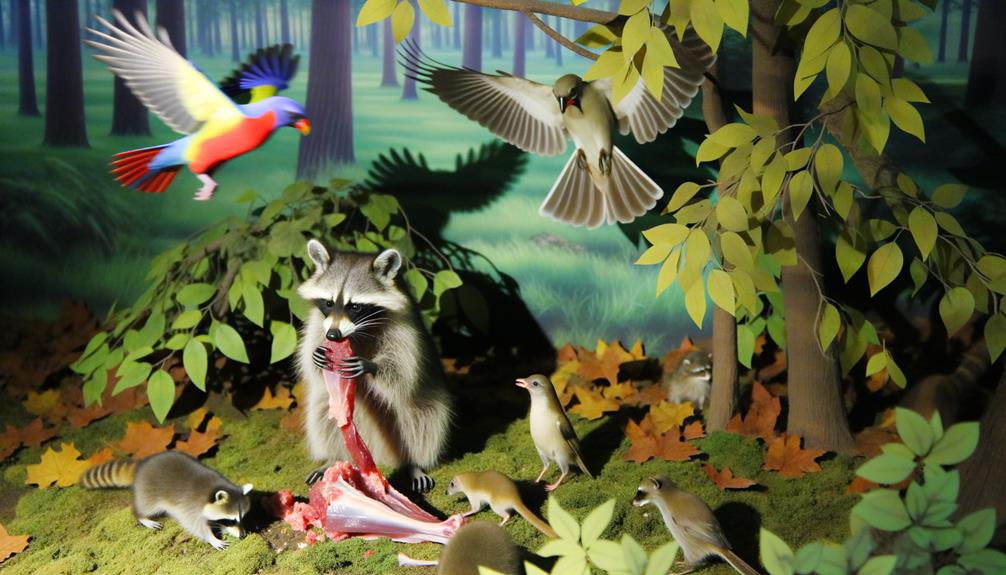
The consumption of raw meat by raccoons can heavily alter local ecosystems by impacting prey populations and influencing the balance of predator-prey dynamics. Empirical studies indicate that raccoons, as opportunistic omnivores, can significantly decrease populations of small mammals, birds, and amphibians.
For instance, research documented a 60% decline in ground-nesting bird populations in areas with high raccoon densities. This predatory pressure can lead to trophic cascades, where changes in prey populations affect vegetation and other wildlife. Additionally, raccoon predation on species such as amphibians can disrupt nutrient cycles in aquatic ecosystems.
Understanding these dynamics is essential for wildlife management and conservation efforts, as raccoons' feeding behaviors can create cascading effects throughout the ecosystem.
Human-Raccoon Interactions
Given their adaptability and opportunistic feeding behaviors, raccoons frequently come into conflict with humans, especially in urban and suburban environments. These interactions can lead to various challenges for both species, including property damage and health concerns.
Key areas of interaction are:
- Trash Raiding: Raccoons often scavenge through garbage bins, leading to litter and potential disease spread.
- Attic and Chimney Nesting: They may seek shelter in human dwellings, causing structural damage.
- Pet Food Theft: Raccoons consume pet food left outdoors, leading to resource competition.
- Garden Destruction: They can damage gardens and crops while foraging for food.
- Disease Transmission: Raccoons are known carriers of rabies and other zoonotic diseases, posing risks to pets and humans.
These interactions necessitate effective management strategies to mitigate conflicts.
Conclusion
Raccoons exhibit a multifaceted diet heavily influenced by seasonal variations, foraging behavior, and inherent hunting skills. Their carnivorous tendencies prompt them to seek various protein sources, including raw meat, which they avidly consume.
This dietary flexibility allows raccoons to impact local ecosystems in a notable manner, often interacting with human environments. Their insatiable appetite for raw meat is akin to a voracious predator, underscoring the complexity of their ecological role and the adaptive strategies that sustain their survival.

